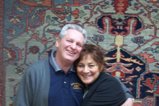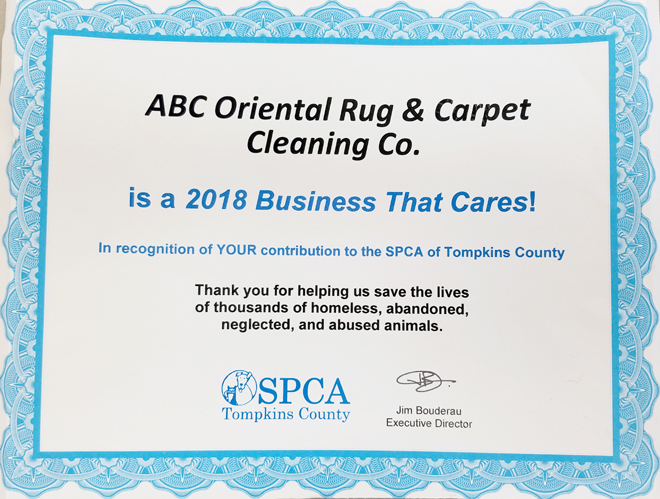ABC MONTHLY NEWSLETTER
OCTOBER 2020
Welcome to Our Monthly Newsletter!
We hope you will enjoy this month's articles.
This month's topics are:
COVID-19 PANDEMIC
Cherry Picking Data & COVID-19
AREA RUGS
MISCELLANEOUS
CONSIGNMENT RUGS FOR SALE REMINDER
If there is a topic you would like us to cover in one of our upcoming newsletters, please call us at
607-272-1566
or contact us by clicking here.
GREAT NEWS!
GOT QUESTIONS?
NOW YOU CAN TEXT US at
607-272-1566
REMINDER:
Don't forget to keep checking our website for our beautiful
We have more than 25 new rugs hanging as of October!
CHERRY PICKING DATA & COVID-19
Cherry picking data is the act of selecting evidence or research that supports a certain position, often a controversial one, while completely ignoring relevant evidence to the contrary.
It does not necessarily mean that one side's information is incorrect, but that a complete picture is not being presented because available evidence to support the other side is not being taken into account.
The problem with
the act of cherry picking data is that when all available information is
not taken into account, the 'cherry picked' information can be
presented in a misleading way. This may lead those who are not aware of
this process to make decisions based on the cherry-picked data only.
In the case of COVID-19, there can be serious repercussions. Those who engage in cherry picking data can do so intentionally or unintentionally.
INTENTIONAL & UNINTENTIONAL CHERRY PICKING DATA
Intentional Cherry Picking Data
Intentional cherry picking data, by purposely omitting available evidence, is often done to make arguments more persuasive, helping to support a particular position.
There is a risk here if people discover the omission of evidence, but it works well where there is a low likelihood that anyone will discover the cherry picking data or even care about it.
An example of intentional cherry picking data is when a person or organization mentions only a small number of studies out of all studies published on a certain topic in order to make it look as if the scientific consensus matches theirs.
Unintentional Cherry Picking Data
Unintentional cherry picking data is an example of one way people process information in order to make decisions.
People who engage in unintentional cherry picking data tend to process information in a way which confirms the beliefs they already have. When people feel they are right and encounter new or remember old information, they tend to focus on information which confirms their beliefs, and ignore information which contradicts them.
People do this even when they are aware of cherry picking data and understand the issues associated with it.
Those who unintentionally cherry pick data find it easier to do so than to process all the available information. It is much easier to pick out a few bits of information from an overwhelming mass of information and base your position on them rather than to carefully analyze all the available information.
EXAMPLES OF CHERRY PICKING DATA
In Politics
Cherry picking data happens all the time in politics. For example, in June, 2020, President Trump claimed that the US was doing well in the battle against COVID-19 because the death rate from the disease was declining. This statement totally ignored the information that new records were being set every day for people testing positive for the SARS-CoV-2 virus.
What we have here is a typical case of 'cherry-picking' of data. It isn't that Trump's information is incorrect, it just doesn't present a complete picture of the situation. And politicians are not the only ones guilty of this type of data reporting. Environmentalists, industry representatives, activists of all sorts, and government officials are all in on the cherry picking harvest!
As we head closer to the 2020 election, one only has to watch the messages from those running for office to see how this fallacy of logic, cherry picking data, works. Examples of this are often found in political arguments and debates when a few specific quotes someone said are cherry-picked out and then repeated out of context in order to misrepresent what that person actually intended to say.
In The Media
Cherry picking data by the media is most evident when disproportional coverage is given to one side of a story while ignoring facts that could support alternative viewpoints.
Although a certain position may be wrong and it might be reasonable to either point this out or oppose it directly, often the rest of the evidence may be less exciting and some less reputable media might prefer to cherry pick the data even if it is inaccurate. This inaccurate data will also usually be more persuasive than the accurate one.
In
regard to COVID-19 and other scientific information, cherry picking
data is often used in the media by denialists, who disagree with the
scientific consensus on various topics, in an attempt to support their
own point of view.
In Scientific Research
There is no lack of controversies in scientific research. Concerns over the safety of plastic components, cosmetic ingredients, medications, pesticides, genetically modified organisms, cell phones, microwave ovens, drinking water, climate science, and the wearing of masks are very controversial subjects.
When people search for guidance on how to tackle these issues, they look for dispassionate, unbiased answers. This is what scientific research should be able to deliver.
But dispassionate, unbiased answers from scientists would exist only in a Utopian world. They would have no preconceived biases, would not be driven by monetary gain, would have access to plentiful funding from unbiased sources, and would have their egos safely tucked away.
Unfortunately, in
the real world, the sheer volume of scientific research is
mind-boggling. Contradictory finds happen, even in the absence of any
bias. Thousands of peer-reviewed research papers are published every
week and not all are of equal quality. As a result of all this,
scientific publications can be found to support almost any point of
view.
EXAMPLES OF CURRENT SCIENTIFIC CONTROVERSIES
Please continue reading here for further information on cherry picking data as well as information on how to recognize and avoid this fallacy of logic.
AUBUSSON RUGS
Aubusson rugs had their beginnings during the Renaissance era (1300s to 1700s) in Europe. We usually associate rug weaving with the East, but the Aubusson rugs of France (as well as the French Savonnerie rugs) were an important part of the history of rug design in the West. These rugs were outstanding examples of French carpet designs which were not influenced primarily by the art of the East.
Aubusson rugs were a very significant part of the revival of the arts of the Renaissance period, especially during the long reign of Louis XIV of France (72 years-1643-1715). The French monarchy under Louis XIV (also known as the Sun King), made France the dominant power in Europe. His reign brought with it the greatest age of French culture. The arts were fully supported and industry flourished.
FIRST LOOMS IN AUBUSSON
The very first looms were probably set up by Flemish refugees in the 1300s in Aubusson, a town located on the banks of the Cruese River in central France, approximately 200 miles from Paris.
The actual production of tapestry and rugs did not begin in Aubusson until the 16th century. The original fine tapestries that were created during Louis XIV's reign morphed into the magnificent rugs and carpets we know today as antique Aubusson rugs and carpets.
THE ORIENTAL RUG COMES TO FRANCE
In the first half of the 16th century, France and the Ottoman Empire began diplomatic and trading agreements. France also began importing knotted-pile carpets from Persia and other eastern Mediterranean regions, exchanging French luxurious goods such as silver for them. It wasn't long before the oriental rug style became a significant trend in renaissance Europe.
The antique rugs were brought to France to establish factories to produce oriental rugs for French regal palaces only. A famous carpet and rug factory, the Savonnerie carpet and rug factory was located where the Museum of Modern Art in France currently stands and was begun in the building of a former soap factory. (The French word for soap is Savon.)
The artists and weavers of the Savonnerie rugs were of the royal courts, and their productions, in the form of fine needlepoint and tapestries, were only available to the King. Savonnerie designs used naturalistic floral motifs, coats of arms and heraldic devices as well as some architectural images.
EARLY AUBUSSON RUGS
The early Aubusson rugs were originally based on Turkish designs, elegantly produced in modified oriental motifs, many with intricate patterns such as the Ushak medallion carpets.
In the 2nd half of the 17th century, their designs changed to mimic the floral and architectural motifs of the Savonnerie rugs, though in simpler versions. Aubusson rugs were available to anyone who could afford them, usually those in the upper class aristocracy of Europe who did not have access to the Savonnerie rugs.
Aubusson textiles had been handwoven in the village of Aubusson since the 15th century. The word Aubusson became associated with a flat-woven French textile because of the pileless weaving tapestry technique used to produce these rugs. (Piled rugs were also made there.) Many of the antique Aubusson rugs have a medallion in the center with flowers and floral arrays surrounding it.
1870-THE END OF FACTORY CARPET & RUG PRODUCTION IN AUBUSSON
The technology of the 1800s brought advanced weaving manufacture to other parts of the world. Former workers of Savonnerie created Axminster looms and the Jacquard loom. In America, Erastus Bigelow invented the steam-powered loom. Factories around the world had a sudden growth in production and efficiency. These advances affected the manufacturing in France. 1870 saw the end of the factory carpet and rug production in Aubusson.
In the 18th and 19th
centuries, tapestry-woven rugs were still woven in Aubusson, but not in
factories. The 20th century saw style in France moving away from the
neoclassical and baroque style and leaning towards contemporary design
inspired by abstract art such as cubism, art nouveau, and art deco.
HOW ANTIQUE FRENCH AUBUSSON RUGS WERE MADE
Please continue reading here for more information on these types of rugs.
DISPOSABLE RUGS
Disposable rugs do exist! Rug cleaners know these rugs as 'garbage rugs, as well as 'disposable rugs.' They are produced by companies employing cheap labor to quickly make poorly constructed rugs they market as hand-crafted.
The Williams-Sonoma Corporation is one of those companies that sells this type of rug. The rugs are made in India and marketed under the brands of Pottery Barn and West Elm. The following is an example of a label found on a West Elm rug:
LIMITED EDITION
Handcrafted
in Rajasthan, India, these rugs are cut, sewn together, heavily washed,
then richly over-dyed to create a beautiful patchwork pattern. Due to
this artisanal dying technique, color may transfer. Keep the rug dry and
use with a rug pad. Colors and textures vary; no two rugs are exactly
alike.
It is so difficult for the uninformed consumer to see the contradictions
in this label. That is why we always thoroughly inspect each rug
brought to our cleaning plant at ABC and then quickly relay the results
of that inspection to our customers. We are driven by our mission to
educate our customers.
It is so difficult for the uninformed consumer to see the contradictions
in this label. That is why we always thoroughly inspect each rug
brought to our cleaning plant at ABC and then quickly relay the results
of that inspection to our customers. We are driven by our mission to
educate our customers.
HOW TO REALLY READ THE ABOVE LABEL
Here is how to really read the above label and others like it:
- 'Handcrafted' does not mean 'handwoven.' India is one of the countries known for employing cheap labor and shoddy workmanship in producing rugs. It does not take much 'handcrafting' to cut and sew together a rug from pieces of rugs. This also means there will be a backing added that will be glued to the back of the rug to keep it together. The glue can fail or produce a very unpleasant odor that cannot be removed.
- 'Heavily washed' could mean the pieces of rug were extra dirty to begin with or also mean the rug was heavily chemically washed.
- 'Richly over-dyed to create a beautiful patchwork pattern' (perhaps to hide the fact that the patchwork pattern has come from rugs that have been cut and sewn together to form that patchwork pattern)?? Over-dyed also means the color will transfer (as they say in the next sentence). Beware that inks will sometimes be used instead of dyes and this can contribute to color loss as well.
- The label says the rug has gone through an 'artisanal dying technique,' which is probably the most honest statement on the label. Dyeing is the proper word for this technique. (Should have checked the spelling before putting the words on a label).
Please continue reading here for more tips and how ABC can help you.
LEVITTOWN
The First Modern American Suburb
Levittown was the first truly mass-produced suburb and is regarded as the archetype of modern American suburbs.
Abraham Levitt, a builder, and his 2 sons created the first and largest postwar suburban community ever.
Levittown will celebrate the anniversary of its grand opening on October 1, 1947, when families first started moving into their new homes 73 years ago.
WHY THE NEED FOR A NEW COMMUNITY?
At the end of WWII, the federal government was faced with a serious problem that grew worse by the day. That problem was a severe housing shortage driven by unprecedented demand.
Millions of military veterans had returned from service to overcrowded cities that imposed a low standard of living and high poverty just when they were eager to begin or expand their families.
The high postwar birthrate further pushed demand for housing. Washington decided they needed 5 million affordable houses immediately. They had two choices, either try to build them or collaborate with private industry. They chose the latter and launched a new standard for the American Dream.
Washington made billions in credit dollars available to construction companies and offered buyers 5-percent mortgages with VA and FHA loans. Within three years, 4 million houses were ready for sale!
ABRAHAM LEVITT & SONS
One of the first builders to take advantage of this informal partnership was Abraham Levitt with his two sons. Abraham's son Alfred was an architect who experimented with new design and construction ideas and William was a whiz at selling.
Until the war, they had specialized in building homes for the upper middle-class in Rockville Centre and Manhasset. They developed and honed their mass-building technique through a government contract for a 2,350 home community in Norfolk, VA in 1941.
During the war, Abraham's son, Bill, served in the Seabees, the Navy construction division, and was based in Oahu. He interviewed soldiers and sailors about their after-war plans. The majority wanted to marry, start a family, and get a house.
Bill recognized the business opportunity for the family firm and sent a telegram to his dad urging him to buy land.
By 1947, Abraham had purchased 4,000 acres of potato fields in Hempstead, NY, 25 miles east of Manhattan. The land was relatively cheap because the potato fields had been affected by an insect that had destroyed most of the crops.
LEVITT, THE HENRY FORD OF HOUSING CONSTRUCTION
Levitt revolutionized home building by becoming the 'Henry Ford of houses.' He used assembly-line production, where each of his 27 non-union workers was trained to specialize in a specific construction task. Each house was finished in 27 steps and took 15 minutes! That added up to 30 new houses per day.
THE LEVITTOWN HOUSES & AMENITIES
To find out more about Levittown, including what the houses offered and what they cost in 1947, their value today, and what has happened in the last 73 years, as well as the unfortunate culture of racism in the early years, please continue reading here.
THANK YOU!! WE LOOK FORWARD TO CONTINUING TO SERVE YOUR TEXTILE CLEANING AND REPAIR NEEDS!
Get New Posts Right To Your Inbox!
Get our monthly newsletter, just like this one, delivered right to your inbox each day. Just sign up and we will send you the best new articles and videos as they become available.
Your email address will NEVER be spammed, sold, or shared. You are welcome to unsubscribe at any time with the link in the email.
Top of October 2020 Newsletter
"The Cleanest Clean You've Ever Seen."
by
ABC Oriental Rug & Carpet Cleaning Co.
130 Cecil Malone Drive Ithaca, NY 14850
607-272-1566

ABC
Carpet & Rug
Spotting Guide

ABC Oriental Rug & Carpet Cleaning Co. has been family-owned and operated in Ithaca and surrounding areas for more 50 years!
Our company is a reflection of our family name and pride.
Please Like us on Facebook!
for more information and to find out what we are doing at our business and in the community!
Stay Connected!
Links to Our Services
Allergy Cleaning
Area Rug Cleaning
Oriental Rug Cleaning
Rug Hand & Machine Repair
Upholstered Furniture Cleaning
Tile & Grout Cleaning & Sealing
We are proud sponsors of the SPCA of Tompkins CO:

Newsletter Archives Categories
~~~~~
~~~~~
Area Rugs & Wall-to-Wall Carpet
~~~~~
General Cleaning, Do-It-Yourself, & Green Cleaning
~~~~~
Wood Floor Coverings & Alternatives
~~~~~
~~~~~
Ceramic Tile & Grout Cleaning & Sealing
~~~~~
Health & Environmental Concerns
~~~~~
~~~~~




